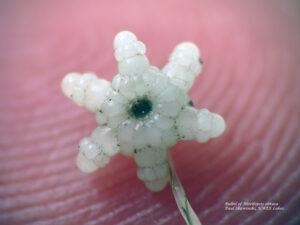Starry Stonewort
Aquatic plant management: starry stonewort
 What is starry stonewort?
What is starry stonewort?
Starry stonewort (scientific name: Nitellopsis obtusa) is a bushy, bright green macroalgae. It looks similar to many native, beneficial grass-like algae, such as other stoneworts and muskgrasses found in inland lakes but can be distinguished based on its production of star-shaped bulbils. These white, star-shaped bulbils (about the size of a grain of rice) form on clear threads at the base of the plant. A macro-algae like starry stonewort does not have a vascular system like true plants; each branchlet or stem is a single cell. Starry stonewort can spread from stem fragments and/or bulbils. It may form a dense carpet of material in shallow areas that may impede recreational activities and ecologically significant events, such as fish spawning areas, although the severity of ecological and recreational impacts are still under investigation.
Can it be controlled?
Many researchers and state agencies have tried a variety of control strategies to reduce starry stonewort. Unfortunately, most of these strategies have not resulted in significant control or eradication of starry stonewort. While many treatment service providers advocate the use of copper or diquat to control starry stonewort, these herbicides have to be used repeatedly in order to be effective. Copper-based algaecides, especially chelated copper products, can reduce starry stonewort biomass and remove the majority of it from the water column. If there is a dense patch of starry stonewort growing by a water access, this reduction can help prevent it from becoming entangled in boat motors and spreading to other water bodies. While copper may provide reduction in the short-term, the use of it is not recommended for long-term control of large established populations. Copper-based algaecides have non-target impacts on native plant species, especially native macro-algae such as muskgrasses and stoneworts. Copper can be toxic to a range of wildlife, including fish. Given the serious impacts from copper on beneficial plants and animals for limited and short-term reduction in starry stonewort, physical or mechanical methods are recommended. Hand-pulling or mechanical harvesting will provide immediate short-term reductions in starry stonewort populations, with potential reductions in following years. In one example, hand-pulling of starry stonewort was done annually in Grand Lake (Minnesota) from 2017-2021. In 2017, approximately 450 pounds were collected, whereas in 2021 fewer than 15 pounds were collected.
Where do I find out more?
Starry stonewort is still spreading throughout inland lakes in the region. Whether or not your lake has starry stonewort, aquatic plant monitoring is an important control strategy to detect starry stonewort early and/or see how it is spreading. (See “Monitoring” fact sheet for more information.) Early detection may not lead to eradication, but it will make subsequent mechanical/physical control efforts less costly and labor intensive.
If your lake has nuisance levels of starry stonewort, you should contact a lake management service provider to help determine whether control efforts are appropriate and, if so, how to proceed. (See the “Management Plan” fact sheet for information on finding a lake management service provider.) The state’s natural resource agency is also a good resource for technical advice on the management of nuisance and invasive aquatic plants. Factors that may determine whether and how control is attempted include: How much of the lake is populated by starry stonewort? Are the patches only starry stonewort, or are there also native plants? Has the amount of starry stonewort been staying about the same or increasing? If you’d like to start small-scale control efforts (such as hand-pulling), contact your local Extension agency since improper pulling technique may worsen the issue. They can also help confirm if you have starry stonewort and help determine if there are native plants mixed in with the starry stonewort that should not be pulled.